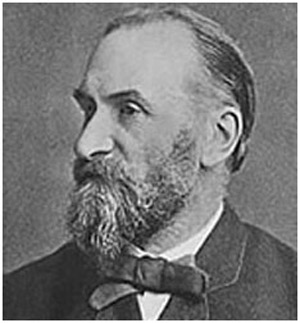William Grylls Adams facts for kids
Quick facts for kids
William Grylls Adams
|
|
|---|---|
 |
|
| Born | 18 February 1836 Laneast |
| Died | 10 April 1915 Broadstone |
| Occupation | Physicist, astronomer, philosopher |
William Grylls Adams (born February 18, 1836, died April 10, 1915) was a smart scientist and professor. He taught about natural philosophy, which is like physics, at King's College, London.
Adams studied many different things. He researched light, magnets, and even space. He also looked into how we can make and send out electricity. One of his big discoveries was finding out that certain materials, like selenium, can make electricity when light shines on them.
Besides his research, Adams was very involved in many science groups. He held important positions in these groups, helping to guide scientific progress.
Contents
Family Life
William Grylls Adams was the youngest of seven children. He had three sisters and three older brothers. His older brother, John Couch Adams, was also a famous scientist who studied astronomy.
His Education and Early Career
Adams went to St. John's College, Cambridge, a well-known university. He did very well there, graduating in 1855. After college, he worked at different schools.
- In 1859, he was a vice-principal at Peterborough Training College.
- In 1860, he taught math at Marlborough College.
In 1863, Adams moved to King's College, London. There, he worked with another famous scientist, James Clerk Maxwell. Adams taught about natural philosophy, which is an old name for physics. He also taught at Highgate School starting in 1864.
Teaching at King's College
Adams was a leader in making science education better. He especially focused on how science could be used in manufacturing and engineering. He believed that students should learn how to use physics ideas in real-world engineering projects.
This way of teaching was so good that other parts of the department started using it too. Adams also worked hard to get more money for the college. He helped improve the science labs and supported a scholarship program called the Whitworth scholarship.
Amazing Discoveries and Research
William Grylls Adams was interested in many areas of science. His main focus was on light and magnetism.
Light and Electricity
In 1839, another scientist named Alexandre Edmond Becquerel found that light could change how two metal plates worked in a liquid. Adams took this idea further.
Starting in 1871, Adams studied how light affects different materials. He looked at how light's polarization worked. To do this, he created a new tool called a polariscope. This tool helped him study how light behaved in different crystals.
In 1876, Adams and his partner, Richard Evans Day, made a very important discovery. They found that when light shines on a spot where selenium and platinum meet, it creates electricity. This is called the photovoltaic effect. This was the first time anyone showed that electricity could be made from light without any moving parts! This discovery was a big step towards creating the solar cells we use today. They also found that very red or very blue light didn't work as well. They learned that the brighter the light, the more electricity was made.
Magnetism Studies
Even though light was his main focus, Adams also did a lot of research on magnetism. He studied how the strength of a magnet could change how well materials conducted electricity.
Adams also looked at information from magnetographs, which are tools that measure magnetic fields, from different cities in Europe. He compared how magnetic "disturbances" happened at the same time in many places. By studying this data, he gave advice on how to make these machines more accurate.
Other Scientific Interests
Adams was also interested in astronomy, the study of space. He even traveled to Italy to study eclipses, which is when the moon blocks the sun.
He also worked on how to create and send out electrical power. He looked at how to light up lighthouses using electricity. He compared electric lights to oil lamps for Trinity House, a group that manages lighthouses. Adams was a leader in this field. In 1882, he even gave a speech about how efficient the dynamos (electric generators) were at the Crystal Palace.
Besides his work at King's College, Adams was very active in other science groups. He was an "examiner" for physics at the universities of Cambridge and London from 1879 to 1892. This meant he helped grade physics exams.
Science Groups and Awards
William Grylls Adams was a member of many important science groups:
- From 1878 to 1880, he was the President of the Physical Society of London.
- In June 1872, he was chosen to be a Fellow of the Royal Society. This is a very high honor for scientists.
- In 1875, he gave a special speech called the Bakerian Lecture for the Royal Society.
- He was also the president of the Institution of Electrical Engineers.
- He led the math and physics section of the British Association.
Adams often went to lectures by another famous scientist, John Tyndall, at the Royal Institution. He was also part of a committee for the Kew observatory and a member of the board of visitors for the Royal Observatory, Greenwich.
Later Life
In 1905, Adams retired from King's College, London. He moved to a place called Heathfield in Broadstone, Dorset. He passed away there on April 10, 1915, at the age of 79. He was survived by his wife, Mary Dingle, and their three children.
His Published Works
Adams wrote several scientific papers and books about his research:
- Solar Heat: A Substitute Fuel for Tropical Countries, 1878
- The action of light on selenium, 1875
- On the action of light on tellurium and selenium, 1876
- Simultaneous magnetic disturbances
- Alternate current machines
- Testing of dynamo machines

